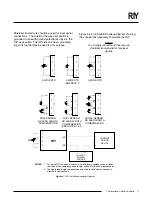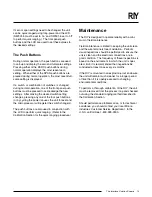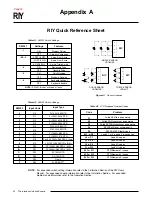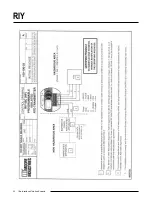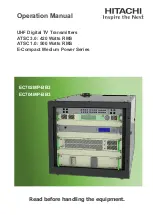
RIY
8
The Interface Solution Experts
˚C
˚F
In standard ranging, input values for zero and span
must first be
captured by the RIY’s microprocessor.
Then, the output can be
trimmed further for a zero-
percent output of 4 mA and a 100-percent output of
20 mA. But to effect any range changes, switch
SW301-6 must be set to the ‘off’ position (keyboard
enable).
Reverse Output.
The RIY can also be set up for
reverse output, where the zero-percent output is 20
mA and the 100-percent output is 4 mA. To setup the
RIY for reverse output operation, the zero and span
settings must cross over one another. These
settings are made by capturing the
greater, or full-
scale, input with the ZERO push buttons as described
in step 7 of the upcoming standard ranging proce-
dure. Then, the span is captured in step 10 with the
SPAN push buttons when the input is zero percent for
a 100-percent output. When the zero output setting is
greater than the span output setting, the unit is
configured for reverse output operation.
Trimming
. ‘Trimming’ is a feature of standard
ranging that allows the user to vary the zero- and
100-percent output values using the ZERO and SPAN
push buttons, respectively.
Trimming the zero-percent setting varies the zero
reference point and the 100-percent output value,
proportionally. For this reason, when a new zero
input value is captured, all previously set trim values
are eliminated. The
span of the output remains
constant while trimming the zero-percent output.
Trimming the 100-percent output with the SPAN push
buttons varies only the full-scale output value; the
zero reference point remains at the level it was last
set to. The zero-percent output should always be
trimmed before trimming the 100-percent output.
Standard Ranging Setup
To perform standard ranging you need an input
source, dc power source, and an output monitoring
device. Table 3 lists the calibration equipment and
the equipment accuracy required to perform this
method of ranging.
Figure 3.
Units-of-Measure Labels for the LCD
‘Ranging’ the RIY
Ranging is a method of field calibration. The RIY
features two methods of ranging;
standard and quick.
To use either method, configuration switch SW301-5
must be set to the desired setting and SW301-6 must
be set to the ‘off’ position (see figure 2).
Before ranging (or calibrating) the RIY, you should
verify all switch settings to ensure that the unit will
operate in a predictable manner. Refer to the sub-
section titled “Using the Configuration Switches”
presented earlier in this section for switch setting
options.
Standard Ranging Overview
Standard ranging is used to set the zero- and 100-
percent output settings of the RIY based on user-
selected input values. The input values are simulated
by calibration equipment to represent actual RTD or
resistance input values. Refer to a resistance-
temperature table for ohm values representative of
RTD temperature values.
Standard ranging is the only field calibration possible
for units without an LCD. Whether your RIY has an
LCD or not, you should rely on the readings from the
calibration equipment while performing standard
ranging.
By setting switch SW301-5 to the ‘off’ position, the
unit is configured for standard ranging (see figure 2).



















